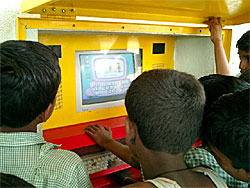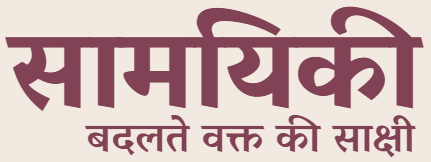An interview with Dr Sugata Mitra
I had interviewed Dr Sugata Mitra for Hindi blogzine Nirantar about an year ago. While going through old emails I came across the original English interview and thought that I should post it online.
Dr Mitra, as you might be aware, is an award winning scientist. He has been known for the Hole in the wall (HIW) project where he proved that kids could learn computers without formal training and teachers. He started the HIW experiment at the slums at Kalkaji, Delhi in 1999. More kiosks were later setup at Shivpuri, Madhya Pradesh and Madantusi, Uttar Pradesh. Sugata calls this “Minimum Evasive Education“, referring to the environment where kids learn using their natural curiosity without the intervention of teachers. The experiment, scaled up to more than 23 kiosks in rural Indian was also repeated in Combodia in 2004.
I am not aware of the real implications of this experiment and whether it went past the academic interests and echoed in the corridors of the government, but the experiment surely suggested a way towards providing low-cost IT education in India.
In the Hole-In-The-Wall (HIW) experiment what is the hardware configuration of the PCs? How do these cope up with the dust/heat of open environment? And in rural areas how did you tackle the issue of dismal power supply? Did you use any customized software?
 Dr Mitra: Personal computers, such as those used in homes and offices all over the world, are designed to work indoors, usually in a carefully conditioned and controlled environment. Such computers can not be placed in outdoor environments, without air-conditioning and with poor power conditions, such as those prevalent in rural India and Cambodia.
Dr Mitra: Personal computers, such as those used in homes and offices all over the world, are designed to work indoors, usually in a carefully conditioned and controlled environment. Such computers can not be placed in outdoor environments, without air-conditioning and with poor power conditions, such as those prevalent in rural India and Cambodia.
Over the period of the experiment, we evolved a design for an enclosure that would enable the usual personal computer to function in an outdoor environment. The enclosure consists of a brick structure resembling a narrow hut with the computer screens visible on the outside of the hut through glass panes fixed to rectangular “holes in the wall” on one side of the hut.
The conventional mouse used with home or office PCs does not function effectively for more than a few days when exposed to outdoors weather. We devised a new solid-state mouse (called ToBu) without any moving parts. The mouse consists of six small metal circles embedded on a plastic plate. These are called touch buttons and need only to be touched with a finger to activate their functions. Four to move the cursor in the left-right and up-down directions, and two for left and right “clicks”. The cursor can also be moved diagonally using a combination of the four touch buttons that control movement.
The keyboard and the ToBu mouse project out from below the monitor through the same rectangular opening in the wall. They are covered by a Perspex cowl that protects from dust. The user inserts his or her hand from under the cowl. The opening below the cowl is wide enough only for small hands to enter. A metal lid covers each monitor and keyboard combination (called the “faceplate”). This is opened during operational hours and forms a sun-shade over the computer. The height of the faceplate and lid are such that adults would need to stoop down at an awkward angle to see the screen. There is a seating rod in front of each computer, placed at a distance from the wall such that it is uncomfortable for tall people.
These design elements are necessary to ensure that only children (usually 13 years and less) access these computers. In rural settings in India, where many adults would not have seen a computer, there is a great deal of curiosity about the device and this can, sometimes, lead to situations where children are not given a chance to operate the computers. Each playground computer is equipped with a web camera and a microphone.
All electrical power is conditioned at the input to correct for voltage spikes, over and under voltage and frequency fluctuations. Four hours of battery back-up is provided for each installation. Sensors inside the enclosure and related software enable us to remotely monitor the following:
- The temperature, humidity and illumination levels inside the enclosure.
- Electrical conditions
- Mouse movement history (when the mouse was moved last).
- History of applications run on each computer
- Screen images on each computer
- Images of children using the computer
- Voice recordings of children speaking
- History of sites visited on the Internet
In addition, software controls ensure that:
- No essential software of data is deleted or renamed.
- The desktop icons are not removed
- The system closes unused programs
- The system restarts when and if a computer hangs.
The entire arrangement is usually placed such that the screens face the north-east. This is to avoid glare from sunlight on the screens. Such playground computers are placed in safe, public locations where their screens are clearly visible to passing adults. This ensures that there are few or no attempts at vandalism, theft or the usage of the computers for accessing pornography or other undesirable material
Amongst the 100 computers placed in the above manner throughout rural India and Cambodia, 4 have been damaged due to vandalism and the access to pornographic material has been estimated at 0.3% of available time, during the four years of the experiment.
With HIW concept we are talking about unmonitored teaching, san the teacher. Do you advocate applying the concept to pre-primary & primary education or would it yield results in higher education as well?
 Dr Mitra: The hole in the wall arrangement is suitable for primary and pre-primary only. But the concept of collaborative, self-regulated instruction can be applied to all age groups.
Dr Mitra: The hole in the wall arrangement is suitable for primary and pre-primary only. But the concept of collaborative, self-regulated instruction can be applied to all age groups.
One of the ironies of our present education system has been that it fails to prepare students for the real-world and get a job. Will such education translate to jobs?
Dr Mitra: Computer skills are essential for any job.
The project has received grants from World Bank and GOI. But how do you foresee the implementation of the idea? What kind of budgets will the government need? Do you think Governments would shelve money for such schemes if they were to continue spending on the conventional education route as well?
Dr Mitra: Not really. I think both methods will need to coexist. The Sarva Shiksha Avijan has funds for innovations and they are using this to put hole in the wall computers in remote areas of India.
Innovative projects like HIW comes, especially in a country like ours, from the stables of Private sector. Why do you think the sarkari think-tanks, who are fed on tax-payers money to germinate such ideas, are unable to device any?
Dr Mitra: I don’t think that is strictly true. There are many important ideas that have been developed by the Government. The Space program for example. However, speed and the ability to take new ideas to the market are lacking in the Government.
Can the Internet replace teachers? How do think we could counter the perils of pornography and the known risks of net-life to which kids are most vulnerable?
Dr Mitra: Most of these risks are non-existent in public hole in the wall computers. Visibility of the screen to passing adults and the fact that all usage is in groups ensure social control that prevents both misuse and vandalism.
One of the observations of the HIW that we read was that the children use metaphor for components. NIIT has been synonymous with computer education where you charge people to teach terminologies. Isn’t learning terminologies an important part of education?
Dr Mitra: Could be. Here, they are learning to use a computer. The learning is purely functional. Its like learning to drive a car – it doesn’t really matter whether you know what a carburetor is or how gears work.
Will NIIT consider adapting its course material based on the findings of HIW?
Dr Mitra: Yes.
In a way, we feel, the HIW experiment has shown that an informal, unconventional education system that teaches through games and provides interactive learning works better. Why do you think only computers can achieve that goal? Is it akin to simply aiming to creating computer-literate citizens suitable only for white-collared jobs?
Dr Mitra: Maybe there are other ways also. I am only trying to show that learning to use a computer can be self instructional for all children. I think every citizen will need to be computer literate, whatever work they do. Just like everyone needs to know arithmetic, not just white collar workers.
Edutainment probably forms the basis of HIW and Kids TV programs call themselves that. How do you rate the present TV programming for kids, especially in the cable TV era? Where do you think they have failed or need to improve on?
Dr Mitra: There are good and bad TV programs. The more the edutainment the better they are. For example, Natgeo, Discovery, etc. are very good.
There is a fact that many would find intriguing. We are nation where rural sector still doesn’t have basic infrastructure, there is wide-spread lack of basic health-care and education. And here we are talking about bridging the digital divide first. Isn’t this an urban dream really? Does it really matter for the real India?
Dr Mitra: Ask the village people. I think our urban idea about villages should and should not have is where we go wrong. They want cable TV, the Internet and Revlon, for example. But we in the cities think only we should have those things and not them.
Has HIW been implemented in other countries as well? How has been the response?
Dr Mitra: Yes, in Cambodia and South Africa. Results are identical to India.
What is usually the minimum age -group/education of the target group in any HIW experiment?
Dr Mitra: Age group: 6 or less to 15 or so. Education level – not important or required, even illiterates can learn to use the computer.
There is a lot of Indian language content now a day on the net. How do you see the trend? What has been the catalyst of this growth according to you? How do you foresee the future?
Dr Mitra: Indian content will come from Indians. The more the access the more the content will become. Eventually, one-sixth of the Internet will be in Indian languages, just as one-sixth of humanity is Indian.
We read about complex systems in an article of yours. Would you like to relate the ‘Social bookmarking sites” and “Blog Unconferences” to this paradigm?
Dr Mitra: Yes, they are all self organizing complex systems. I have two papers on the subject.
What are your views on the GOI rejecting the One Laptop per child grant? Do you agree with their arguments?
Dr Mitra: I don’t know their arguments. I don’t think one should accept or reject anything without first measuring their effectiveness.
What’s currently keeping you occupied?
Dr Mitra: Educational technology, self-organising systems etc.





